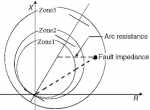mbrooke
Batteries Included
- Location
- United States
- Occupation
- Technician
I'm curious. Why didn't they just make an MHO (step distance) branch circuit breaker?
You will always get consistent fault reach no matter the fault current at the panel, with a few cycle delay built in to allow for inrush.
At lost less complicated and cheaper than what we're doing now.
You will always get consistent fault reach no matter the fault current at the panel, with a few cycle delay built in to allow for inrush.
At lost less complicated and cheaper than what we're doing now.




